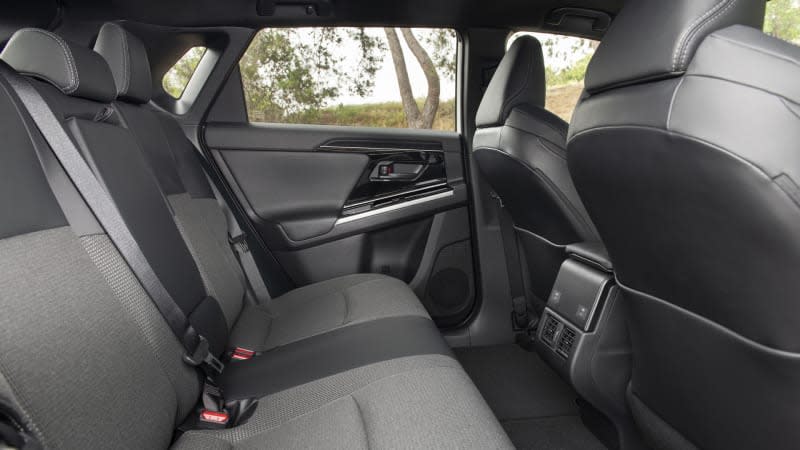2023 Toyota bZ4X Review | An electric Toyota finally arrives

Pros: Good value with FWD; a relatively conventional small SUV; high ground clearance for an EV; useful interior storage
Cons: Subpar range with AWD; slower to charge than some rivals; shine-in-your-eyes interior trim; hide-your-eyes styling
This may come as a surprise, but the 2023 Toyota bZ4X is the first from-scratch electric Toyota. And no, the handful of RAV4 EVs produced to please California regulators do not count. Turns out the company that popularized the hybrid has been hesitant to join the all-electric revolution. The bZ4X speaks to that hesitancy: it’s an exceedingly safe effort with RAV4-like styling, as well as range, power and recharging specs that are hardly ambitious. Toyota even split the development with Subaru, which calls its AWD-only version the Solterra. For those wishing Toyota still sold a RAV4 EV today, the bZ4X should probably satisfy. For everyone else, there are ultimately more compelling EVs.
At the same time, certain versions of the bZ4X present a strong value case. Specifically, the front-wheel-drive versions. You see, most other EVs like the Hyundai Ioniq 5, Kia EV6 and Volkswagen ID.4 come standard with a single motor powering the rear wheels. Their optional all-wheel-drive systems, which add a second motor for the front wheels, will be a must in wintery climates, but bring with them hefty performance and price increases. The AWD bZ4X instead swaps out its large front motor for a pair of smaller motors mounted one apiece to each axle – the performance upgrade is barely noticeable, but the price increase is roughly the same as what you’d find with gas-powered SUVs. Front-wheel drive is perfectly acceptable for winter, too, so you can easily bypass the AWD option altogether and enjoy more acceptable range (258 miles versus 228).
Basically, it’ll be easier for more people to live with a base-model bZ4X XLE than the similarly priced Ioniq 5, EV6 and ID.4. It’s a more competitive car when cheaper, and is equipped well enough that you shouldn’t feel shortchanged. Just don’t expect something as fully realized as the exceptional Ioniq 5 and EV6, nor even the characterful but flawed ID.4. Safe isn’t a terrible way to go (Toyota sold 400,000 RAV4s last year), but we wish Toyota had been more ambitious, at least with the powertrain.
Interior & Technology | Passenger & Cargo Space | Performance & Fuel Economy
What it's like to drive | Pricing & Trim Levels | Crash Ratings & Safety Features
What's new for 2023?
The bZ4X is an all-new model.



What are the bZ4X interior and in-car technology like?
The bZ4X strikes a nice balance between functionality and achieving the more futuristic aesthetic typically demanded of an EV. Basically, it’s not too weird. There are physical toggles for temperature settings and the accompanying touch-sensitive climate buttons are illuminated and seemed responsive enough during our first drive (that said, we’d prefer a volume knob). The shifter is yet another new-fangled design that’s different for different’s sake, but was also easy enough to figure out. More basic vehicle functions are still served by buttons and stalks. We also like the abundance of storage up front, including an enclosed bin for your smartphone.
Unfortunately, that bin’s cover and the surrounding trim are gloss black, which horribly attracts fingerprints and managed to consistently reflect the sun into our eyes while driving. The gray fabric on the dash is a much more successful and glare-free interior adornment.
In-car technology is dominated by a standard 12.3-inch touchscreen, which is Toyota’s latest interface shared only with the Tundra. It’s a clear upgrade over what you’d find in other Toyotas, and is generally user friendly. However, we would like a split-screen functionality, like Toyota offers with the Highlander’s widescreen display. The bZ4X also features a unique digital instrument panel placed roughly in between where traditional gauges and a head-up display would be in your line of sight. This means it’s above the wheel rim rather than under it. Shorter drivers might find the rim blocks some of the display’s bottom, but taller drivers should be fine. Toyota will apparently offer a Tesla-like yoke to remedy this, but that seems like a silly work-around “solution” to a problem that doesn’t need to exist.


How big is the bZ4X?
The bZ4X is about 4 inches longer and 2 inches lower than a RAV4, with 2.5 fewer inches of legroom, but that still makes it a compact SUV – just a slightly smaller one, not unlike a Mazda CX-5. It may be less able to fit a rear-facing child seat without scooting a front seat forward as a result of this.
Cargo space is also restricted compared to conventional compact SUVs because of its fastback roofline. It’s actually not unlike the Toyota Prius in its cargo area design, though it’s certainly larger. Its 27.7 cubic-feet is actually the same as the Kia EV6, and given the similar shape, should probably be able to carry as much stuff as the Kia can.


 Yahoo Autos
Yahoo Autos 
